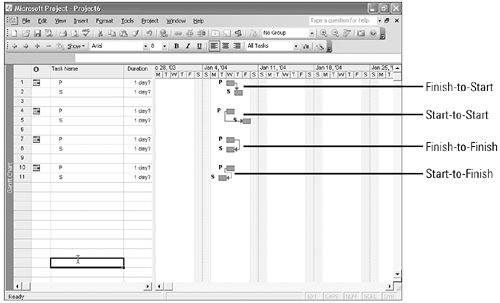| Dependencies are used to create a logical flow among your tasks across time. There are four types of dependencies: Finish-to-Start (the most common), Start-to-Start, Finish-to-Finish, and Start-to-Finish. These are also known among Project users as links . Links are used to tell Project how tasks are related and the order in which they should occur. In each of these links, there are two tasks: the predecessor and the successor. The predecessor is a task that is driving the successor to do something. The successor task cannot achieve its start or finish until the predecessor task has reached its start or finish first. Links help Project keep your project tasks in the right order when something causes tasks to slip (start later than scheduled). Let's take a look at each type of dependency.   | Finish-to-Start | This is the most common link, and it says that the successor task (S) cannot start until the predecessor task (P) has finished. An example of this would be the relationship between the tasks of framing a house and putting up the sheetrock. You cannot sheetrock a house until it has been framed. The sheetrocking task would be a successor to the framing task.  | Start-to-Start | This link tells Project that the successor cannot start until the predecessor has started. An example of this is the way the tasks of writing a document and editing that document are related. You cannot start editing a document until the writing has at least started. This kind of link brings up another aspect of links: lag . Lag allows you to delay the link. An example of lag in the writing/editing of a document is putting in a two-day lag on the link. This would mean that the editing of the document cannot start until two days after the writing starts. The example here shows that the successor task cannot start until two days after the predecessor task starts. Cousin to lag is lead . Actually, lead is just a negative lag. Lead lets you tell Project that the predecessor task should start a number of days before the predecessor event. For example, if you have a task that should start two days before the finish of another task, you would set up a normal Finish-to-Start link with a two-day lead.  | Finish-to-Finish | Similar to the Start-to-Start link, the Finish-to-Finish link says that the successor cannot finish until the predecessor has finished. In the example for the Start-to-Start link, we looked at the tasks of writing and editing a document. Many project managers choose to model this relationship with a Finish-to-Finish link, saying that the editing cannot finish until two days after the writing finishes. Another example of a Finish-to-Finish link is sanding and painting a wall. The painting of the wall cannot finish until the sanding of the drywall seams is complete.  | Start-to-Finish | Most users of Project will never use this rare type of link. This link says that the successor cannot finish until the predecessor has started. An example of this link is the relationship between the tasks of preparing for an event and the event itself, when you want the preparations to go on until the event starts, even if the event start slips out in time. At first, this relationship seems to be modeled best by a Finish-to-Start link, and this is commonly how it is done. But if you want the preparations to continue until the very last minute, the Start-to-Finish link is the best way because in a Finish-to-Start relationship, the preparation task finish date would not automatically be moved out if the start of the event task was moved out a week. |